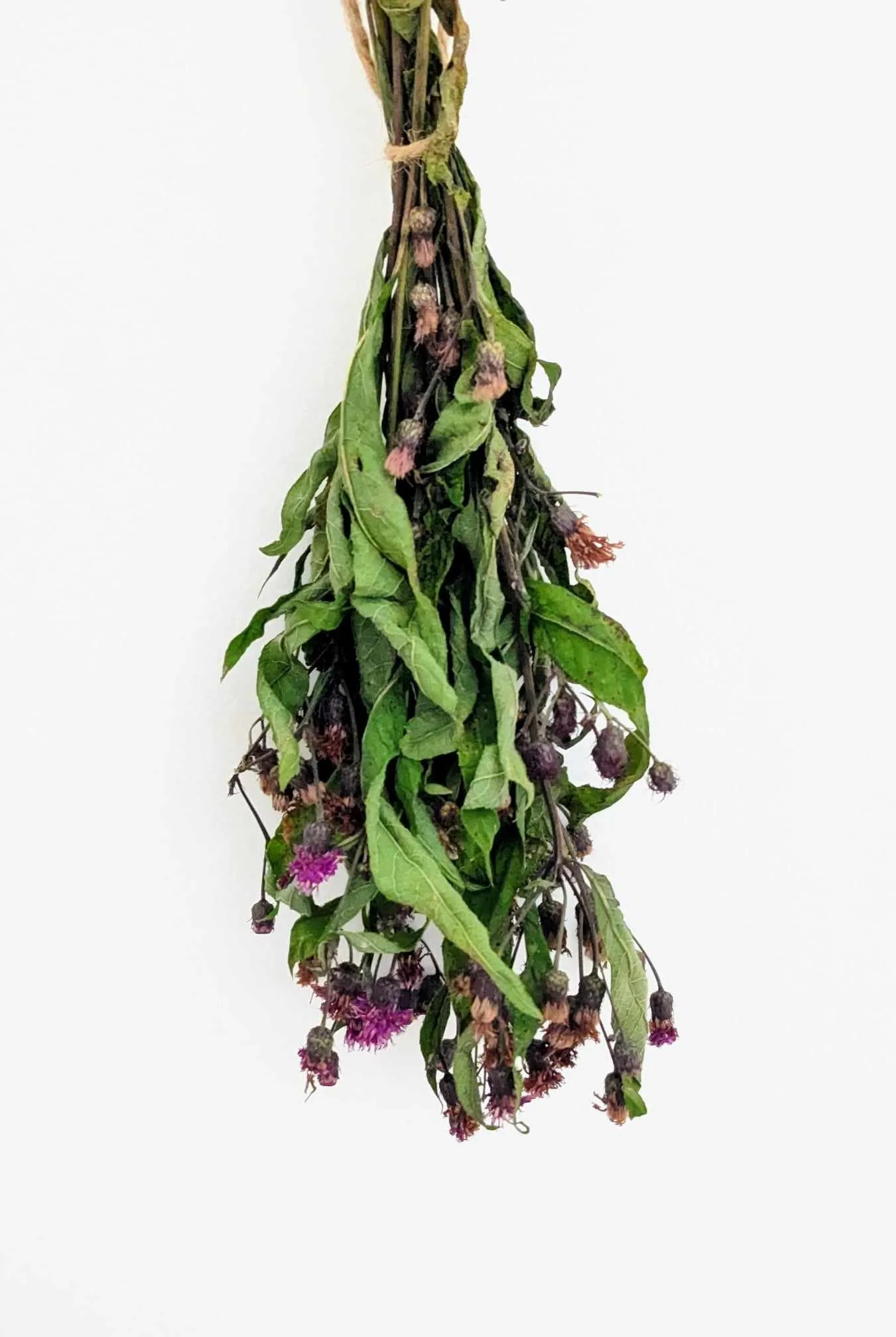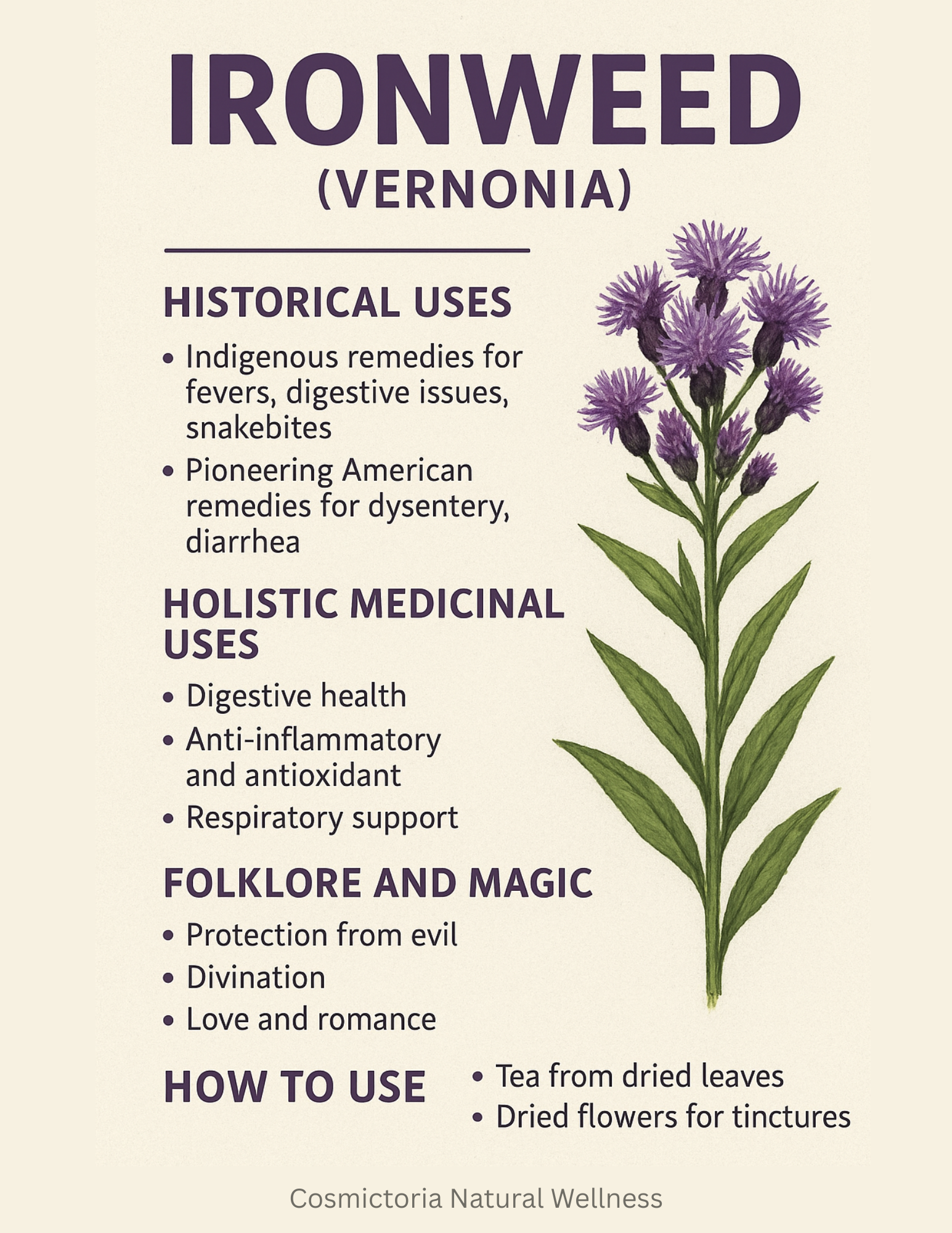Healing Herbs: Ironweed (Vernonia)
With its fierce purple bloom rising proudly from meadows and wetlands, Ironweed (Vernonia) has long symbolized resilience — both in nature and in the people who have turned to it for healing. This rugged wildflower, scientifically known as Vernonia, boasts a rich history filled with both practical medicinal uses and enchanting folklore magic. In this article, we'll explore the holistic and medicinal applications of ironweed, as well as delve into the fascinating world of its historical and mystical uses.
What is Ironweed (Vernonia)?
Ironweed is a native North American plant belonging to the Vernonia genus, which includes over 100 species. It is renowned for its resilience and ability to thrive in a variety of habitats, from meadows to prairies and wetlands. The plant derives its name "ironweed" from its strong, sturdy stem and iron-like toughness.
Historical Uses
Indigenous Healing Wisdom: Indigenous communities in North America have a long history of using ironweed for various medicinal purposes. Traditionally, it was employed to treat ailments such as fevers, digestive issues, and even snakebites. The leaves and roots were often brewed into teas or poultices for these healing purposes.
Pioneering American Remedies: During the 18th and 19th centuries, settlers in North America adopted ironweed as part of their home remedies. It was frequently used to alleviate symptoms of dysentery, diarrhea, and other gastrointestinal troubles. Its astringent properties made it valuable in addressing bleeding and wound care.
Holistic Medicinal Uses
Digestive Health: Ironweed continues to be cherished for its digestive benefits. It is believed to have mild laxative properties that can help soothe stomach discomfort and relieve constipation. A simple tea made from its dried leaves can provide gentle relief.
Anti-Inflammatory and Antioxidant: Recent scientific studies have revealed that ironweed contains compounds with potent anti-inflammatory and antioxidant properties. These properties make it a potential ally in the management of chronic conditions like arthritis and heart disease.
Respiratory Support: Traditional herbalists also recommend ironweed for respiratory issues. Its expectorant qualities can help loosen mucus and alleviate symptoms of coughs and colds.
Ironweed Folklore and Magic
Ironweed has not only been cherished for its medicinal properties but has also been a prominent character in folklore and magical practices:
Protection from Evil: In some cultures, ironweed was believed to ward off evil spirits. Hanging bundles of dried ironweed over doorways was thought to protect homes from malevolent forces.
Divination: Ironweed was sometimes used in divination practices. Its tall, straight stems and distinctive purple flowers made it suitable for crafting divining rods, which were used to locate hidden sources of water or lost objects.
Love and Romance: Ironweed also found its way into love spells and charms. Some believed that carrying a piece of ironweed could attract love or strengthen existing relationships.
While the leaves and roots of ironweed are often the primary focus for medicinal and practical applications, its vibrant purple flowers should not be overlooked. These blooms, which appear in late summer and early autumn, possess their own unique qualities and uses. The flowers, when dried, can be employed in herbal teas or tinctures, offering a milder yet equally effective alternative to the leaves. Their gentle, floral flavor adds a delightful note to herbal concoctions. Furthermore, in the realm of folklore and magic, the flowers are often associated with themes of transformation and spiritual growth, making them a valuable addition to rituals and ceremonies aimed at personal development and inner healing.
How to Use: Ironweed can be prepared as a gentle herbal tea by steeping 1 teaspoon of dried leaves in a cup of hot water for 10–15 minutes. The dried flowers may also be used in tinctures or blended with other herbs for a milder flavor. As with all wildcrafted plants, harvest responsibly and consult a qualified herbalist before internal use, especially if pregnant or taking medication.
Note: While traditionally used for these purposes, always consult a qualified herbalist or healthcare provider before internal use. Harvest ironweed sustainably, leaving plenty for pollinators and future growth.
In all, ironweed is a helpful plant that embodies both the practical and mystical aspects of traditional herbalism. Its holistic medicinal uses continue to offer relief to those seeking natural remedies, while its folklore and magical associations provide a glimpse into the deep-rooted connections between nature and human culture. Whether you encounter it in the wild or cultivate it in your garden, ironweed is a remarkable plant!
If you love learning about the folklore and healing power of native herbs, explore the next plant in our Healing Herbs series: American Persimmon


